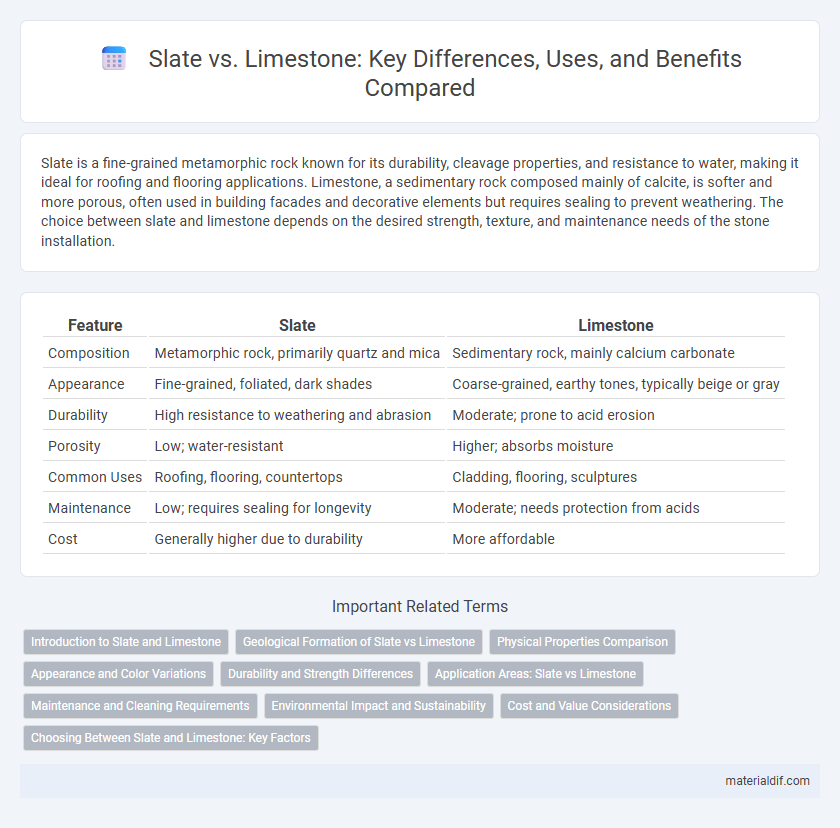Slate is a fine-grained metamorphic rock known for its durability, cleavage properties, and resistance to water, making it ideal for roofing and flooring applications. Limestone, a sedimentary rock composed mainly of calcite, is softer and more porous, often used in building facades and decorative elements but requires sealing to prevent weathering. The choice between slate and limestone depends on the desired strength, texture, and maintenance needs of the stone installation.
Table of Comparison
| Feature | Slate | Limestone |
|---|---|---|
| Composition | Metamorphic rock, primarily quartz and mica | Sedimentary rock, mainly calcium carbonate |
| Appearance | Fine-grained, foliated, dark shades | Coarse-grained, earthy tones, typically beige or gray |
| Durability | High resistance to weathering and abrasion | Moderate; prone to acid erosion |
| Porosity | Low; water-resistant | Higher; absorbs moisture |
| Common Uses | Roofing, flooring, countertops | Cladding, flooring, sculptures |
| Maintenance | Low; requires sealing for longevity | Moderate; needs protection from acids |
| Cost | Generally higher due to durability | More affordable |
Introduction to Slate and Limestone
Slate is a fine-grained metamorphic rock formed from shale under low-grade regional metamorphism, known for its durability, natural cleft surface, and rich color variations including gray, green, and purple. Limestone is a sedimentary rock primarily composed of calcite, formed from marine organisms' skeletal fragments, characterized by its porous texture and light color range from white to beige. Both stones are widely used in construction and design, with slate favored for roofing and flooring due to its cleavage properties, while limestone is common in architectural facades and sculptural elements because of its workability.
Geological Formation of Slate vs Limestone
Slate forms through the low-grade regional metamorphism of shale or mudstone, characterized by the recrystallization of clay minerals under pressure and heat over millions of years. Limestone originates primarily from the accumulation and compaction of marine skeletal fragments such as coral and mollusks, composed mainly of calcium carbonate (CaCO3), deposited in warm, shallow marine environments. The distinct geological processes result in slate's foliated, fine-grained texture and limestone's sedimentary, often fossil-rich structure.
Physical Properties Comparison
Slate exhibits a fine-grained, foliated texture with excellent cleavage, allowing it to split into thin, durable sheets ideal for roofing and flooring. Limestone, composed mainly of calcite, has a granular texture and is softer with a Mohs hardness of around 3-4 compared to slate's 5.5, making limestone more prone to scratching and weathering. Slate's low porosity provides better water resistance, whereas limestone's higher porosity can lead to increased susceptibility to erosion and staining.
Appearance and Color Variations
Slate features a fine-grained, foliated texture with a natural cleft surface that often displays shades of gray, black, green, and purple. Limestone exhibits a more uniform, granular texture with colors ranging from off-white and beige to soft yellows and light browns. Both stones offer versatile color palettes, but slate's layered appearance contrasts with limestone's smoother, more consistent look.
Durability and Strength Differences
Slate exhibits superior durability and strength compared to limestone due to its metamorphic origin, resulting in a dense, fine-grained structure resistant to weathering and impact. Limestone, a sedimentary rock, is softer and more porous, making it more susceptible to chipping, erosion, and acid rain damage. For applications requiring long-lasting performance and high resistance to mechanical stress, slate is often preferred over limestone.
Application Areas: Slate vs Limestone
Slate excels in roofing, flooring, and wall cladding due to its durability, natural cleavage, and water resistance, making it ideal for exterior and high-moisture environments. Limestone, softer and more porous, is preferred for decorative interior elements, sculptural works, and landscaping where ease of carving and aesthetic warmth are valued. Both stones serve unique applications: slate for structural and weather-resistant uses, limestone for ornamental and architectural detailing.
Maintenance and Cleaning Requirements
Slate requires low maintenance due to its dense, non-porous surface that resists stains and moisture, making it ideal for high-traffic areas. Limestone is more porous and softer, necessitating regular sealing and gentle cleaning with pH-neutral products to prevent etching and staining. Both stones benefit from prompt spill cleanup, but limestone demands more careful upkeep to maintain its appearance over time.
Environmental Impact and Sustainability
Slate exhibits superior environmental sustainability due to its natural durability and low maintenance requirements, reducing the need for frequent replacement and minimizing resource consumption. Limestone quarrying tends to generate higher dust and particulate emissions, contributing to local air pollution and habitat disruption. Both stones have carbon footprints linked to extraction and transportation, but slate's longer lifespan often results in a lower overall environmental impact.
Cost and Value Considerations
Slate generally costs more than limestone due to its durability and aesthetic appeal, making it a preferred choice for premium flooring and roofing projects. Limestone offers a more affordable option but may require more maintenance over time, impacting its long-term value. Choosing between slate and limestone depends on balancing initial cost with durability and design preferences for optimal investment value.
Choosing Between Slate and Limestone: Key Factors
Slate offers superior durability and water resistance, making it ideal for roofing and outdoor applications, while limestone provides a softer, warmer aesthetic suitable for indoor flooring and walls. The mineral composition of slate ensures high resistance to weathering, whereas limestone's porous nature requires sealing to prevent staining and damage. Cost and maintenance considerations also play key roles, with slate typically demanding less upkeep and a higher initial investment compared to limestone.
Slate vs Limestone Infographic

 materialdif.com
materialdif.com